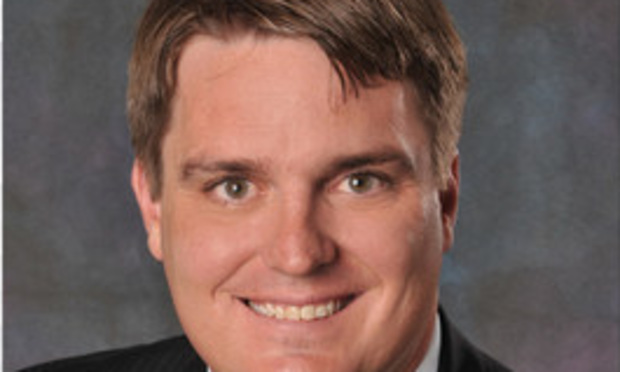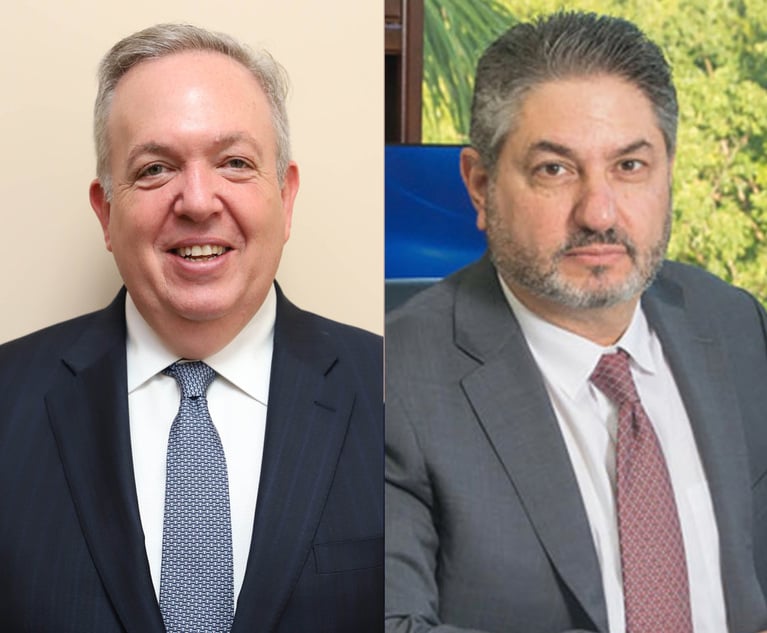Fla. Supreme Court Finds Insurers Liable From Onset of Construction Defect Pre-Suit Process
In Florida construction defect cases, does the statutory process embodied by Chapter 558 of the Florida Statutes, which is a condition precedent to commencing litigation, constitute a “suit” that must be recognized and adjusted by a contractor's liability insurer? That was the question that a federal appellate court put to the Florida Supreme Court.
January 02, 2018 at 11:15 AM
6 minute read

In Florida construction defect cases, does the statutory process embodied by Chapter 558 of the Florida Statutes, which is a condition precedent to commencing litigation, constitute a “suit” that must be recognized and adjusted by a contractor's liability insurer? That was the question that a federal appellate court put to the Florida Supreme Court.
The Florida construction industry has been closely watching the case of Altman Contractors v. Crum & Forster Specialty Insurance since a decision was issued last year by the U.S. Court of Appeals for the Eleventh Circuit, which certified the question to the Florida Supreme Court.
In mid-December, the state's highest court held that the pre-litigation notice and repair process does indeed constitute a claim which the carrier must recognize.
The state's pre-litigation defect procedure, outlined in Chapter 558, was enacted in 2003 to provide a means by which property owners could notify builders of alleged construction or design defects. The responsible contractors, subcontractors and design professionals must then either voluntarily resolve the defects or deny liability. The goal of the statute was to reduce the amount of complex, multiparty construction defect litigation, which had ballooned during the building boom prior to the collapse of the housing market and the foreclosure crisis.
For major construction projects such as residential and commercial high rises, the process usually takes several months and involves a number of inspections by contractors, subcontractors and designers. Similar procedures have been adopted by the majority of states due to the high costs associated with construction defect litigation and the burdens that these cases place on the courts.
Significant Question for Construction Industry
The question of whether the 558 process is considered a claim under a standard commercial general liability (CGL) policy is extremely significant for the state's construction industry. In Altman, the Eleventh Circuit court considered the contractor's appeal of a summary judgment from the U.S. District Court for the Southern District of Florida, which had determined that the Chapter 558 process was not a suit, and thus not a claim, within the meaning of the standard CGL policy.
The general liability policy required the insurer to defend the contractor from any suit seeking damages caused by bodily injury or property damage, but the federal district court ruled that because the Chapter 558 process does not provide for a final decision on disputed liability, it falls short of the policy's definition of a lawsuit.
On appeal, the contractor argued that the 558 process is part of a suit because it is mandated by state law before a suit can be filed. The Eleventh Circuit found that both the contractor and insurer presented reasonable interpretations of the term, but because there was no ambiguity in the policy over what constitutes a “suit” it was required to accept the contractor's interpretation. The court determined that its decision would have significant ramifications for the state's construction and insurance industries, so it certified the question for the Florida Supreme Court to resolve.
The state's Supreme Court found that the policy defines suit, in part, as “a civil proceeding in which damages … are alleged.” Thus, in order to be a claim by that definition, the 558 process must constitute a civil proceeding.
After reviewing several definitions, the justices found that the notice and repair process cannot be considered a civil proceeding under the policy terms because the recipient's participation is not mandatory—the notice recipients may choose to not respond, which then forces the claimant to file a lawsuit.
In addition, the justices concluded that the process does not take place in a court of law, employ any type of adjudicatory body, nor produce legally binding results. Rather, it establishes a pre-suit process in which the claim may be resolved through a negotiated settlement or voluntary repairs without the filing of a lawsuit, so it does not constitute a civil proceeding within the policy definition of suit.
Pre-Suit Process Is an ADR Proceeding
In Altman, however, the policy broadened the definition of a suit to include “any other alternative dispute resolution proceeding in which such damages are claimed and to which the insured submits with our consent.” Looking to the plain meaning of the policy's terms, alternative dispute resolution was defined as “a procedure for settling a dispute by means other than litigation.”
The court concluded that the process falls within this definition as a statutorily required pre-suit process aimed to encourage the claimant and insured to settle claims without resorting to litigation. It found that the process is therefore considered an alternative dispute resolution proceeding within the plain meaning of this policy term.
After reaching this conclusion, the justices ruled “that the notice and repair process set forth in Chapter 558 constitutes a suit within the meaning of the commercial general liability policy issued by C&F to Altman. Although the Chapter 558 process does not constitute a civil proceeding, it is included in the policy's definition of suit as an alternative dispute resolution proceeding to which the insurer's consent is required to invoke the insurer's duty to defend the insured.”
The implications of this decision are vexing. On one hand, insurers may choose to assist in resolving claims prior to a suit being initiated. On the other hand, inclusion of insurers into the 558 process could make an already complicated process even more cumbersome. In that case, the statutorily prescribed 120-day time period could be difficult to meet.
Furthermore, once the insurer is involved, the insured's ability to resolve issues could be hampered. That said, if the insurer is not involved, an insured that resolves an issue that could be covered might jeopardize coverage based upon the voluntary payment provision in the policy. Moreover, the requirement of “insurer consent” further muddies the water.
In any case, the insured claimant will be wise to provide the insurer with notice of any 558 claim. How the process unfolds thereafter will be interesting to see.
B. Michael Clark Jr. is a partner with Siegfried, Rivera, Hyman, Lerner, De La Torre, Mars & Sobel in Coral Gables. He has focused on construction and insurance law since 2007 and is a Florida bar board certified construction law specialist. Contact him at [email protected]
This content has been archived. It is available through our partners, LexisNexis® and Bloomberg Law.
To view this content, please continue to their sites.
Not a Lexis Subscriber?
Subscribe Now
Not a Bloomberg Law Subscriber?
Subscribe Now
NOT FOR REPRINT
© 2025 ALM Global, LLC, All Rights Reserved. Request academic re-use from www.copyright.com. All other uses, submit a request to [email protected]. For more information visit Asset & Logo Licensing.
You Might Like
View All
SEC Whistleblower Program: What to Expect Under the Trump Administration
6 minute read
Turning the Shock of a January Marital Split Into Effective Strategies for Your Well-Being
5 minute read

Trending Issues in Florida Construction Law That Attorneys Need to Be Aware Of
6 minute readTrending Stories
- 1Public Notices/Calendars
- 2Wednesday Newspaper
- 3Decision of the Day: Qui Tam Relators Do Not Plausibly Claim Firm Avoided Tax Obligations Through Visa Applications, Circuit Finds
- 4Judicial Ethics Opinion 24-116
- 5Big Law Firms Sheppard Mullin, Morgan Lewis and Baker Botts Add Partners in Houston
Who Got The Work
J. Brugh Lower of Gibbons has entered an appearance for industrial equipment supplier Devco Corporation in a pending trademark infringement lawsuit. The suit, accusing the defendant of selling knock-off Graco products, was filed Dec. 18 in New Jersey District Court by Rivkin Radler on behalf of Graco Inc. and Graco Minnesota. The case, assigned to U.S. District Judge Zahid N. Quraishi, is 3:24-cv-11294, Graco Inc. et al v. Devco Corporation.
Who Got The Work
Rebecca Maller-Stein and Kent A. Yalowitz of Arnold & Porter Kaye Scholer have entered their appearances for Hanaco Venture Capital and its executives, Lior Prosor and David Frankel, in a pending securities lawsuit. The action, filed on Dec. 24 in New York Southern District Court by Zell, Aron & Co. on behalf of Goldeneye Advisors, accuses the defendants of negligently and fraudulently managing the plaintiff's $1 million investment. The case, assigned to U.S. District Judge Vernon S. Broderick, is 1:24-cv-09918, Goldeneye Advisors, LLC v. Hanaco Venture Capital, Ltd. et al.
Who Got The Work
Attorneys from A&O Shearman has stepped in as defense counsel for Toronto-Dominion Bank and other defendants in a pending securities class action. The suit, filed Dec. 11 in New York Southern District Court by Bleichmar Fonti & Auld, accuses the defendants of concealing the bank's 'pervasive' deficiencies in regards to its compliance with the Bank Secrecy Act and the quality of its anti-money laundering controls. The case, assigned to U.S. District Judge Arun Subramanian, is 1:24-cv-09445, Gonzalez v. The Toronto-Dominion Bank et al.
Who Got The Work
Crown Castle International, a Pennsylvania company providing shared communications infrastructure, has turned to Luke D. Wolf of Gordon Rees Scully Mansukhani to fend off a pending breach-of-contract lawsuit. The court action, filed Nov. 25 in Michigan Eastern District Court by Hooper Hathaway PC on behalf of The Town Residences LLC, accuses Crown Castle of failing to transfer approximately $30,000 in utility payments from T-Mobile in breach of a roof-top lease and assignment agreement. The case, assigned to U.S. District Judge Susan K. Declercq, is 2:24-cv-13131, The Town Residences LLC v. T-Mobile US, Inc. et al.
Who Got The Work
Wilfred P. Coronato and Daniel M. Schwartz of McCarter & English have stepped in as defense counsel to Electrolux Home Products Inc. in a pending product liability lawsuit. The court action, filed Nov. 26 in New York Eastern District Court by Poulos Lopiccolo PC and Nagel Rice LLP on behalf of David Stern, alleges that the defendant's refrigerators’ drawers and shelving repeatedly break and fall apart within months after purchase. The case, assigned to U.S. District Judge Joan M. Azrack, is 2:24-cv-08204, Stern v. Electrolux Home Products, Inc.
Featured Firms
Law Offices of Gary Martin Hays & Associates, P.C.
(470) 294-1674
Law Offices of Mark E. Salomone
(857) 444-6468
Smith & Hassler
(713) 739-1250






